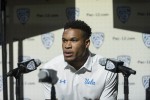Kenny Young believes that safety in football comes down to one question.
“Do you want to be the guy that knocks people out every single play just for entertainment, or are you that guy that cares about your long-term health?” the senior linebacker asked.
During Wednesday’s Pac-12 Media Day, players and coaches answered questions regarding a recently published Boston University study on chronic traumatic encephalopathy, that discovered the debilitating neurodegenerative disease’s presence in 110 of the 111 donated brains of deceased NFL players.
And while the study provides another link between playing many years of football and sustaining irreversible brain damage, Young approaches the topic with a relatively politic point of view.
“I want to play this game a very long time, and it feels like I’ve been playing it for a very long time, but I’m only about to be a senior in college,” Young said. “You make the decision to play football, and whenever you make the decision to do anything, you have to accept the good and bad with that. I’m tackling and I’m hitting somebody every single play.”
For the first time in his college career, Young will no longer have to deal with multiple contact practices a day before the season starts. The NCAA banned two-a-days starting in April as part of its agenda to reduce the number of concussions and fatigue or overuse-related injuries that players suffer.
From a coaching standpoint, coach Jim Mora reiterated that he considers player safety to be paramount.
“The high rate of CTE, that doesn’t just happen when they go to the NFL, that starts at an early age,” Mora said, referring to the Boston University study. “So we have to be conscious of those things. These are young men we’re dealing with, and player safety has to be a premium. The percentage of these young men that go on and make a living at this is miniscule, so I’m in agreement with (eliminating two-a-days).”
The NCAA also implemented a targeting penalty beginning in the 2008 season for hitting a defenseless player above the shoulders or leading a hit with the crown of a helmet. In 2013, the governing body added an automatic two-half ejection for the offending player unless referees determine with video replay that the ejection is not warranted.
Young, who was ejected for targeting early in the first quarter of UCLA’s 2015 game against BYU, said the disqualification helped usher in a new understanding of how to play the game.
“I was pissed, but I went home, and it took me some time – about a week – (and I said) ‘You know, maybe that was meant to happen. Maybe I just need to chill out and play the game (a) little bit more safely,’’’ Young said. “For me it’s about my health, it’s about my safety. So that’s what I’m glad for.”
